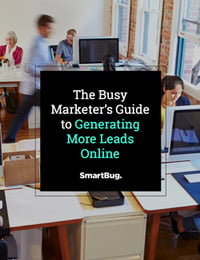
Lead Generation vs. Demand Generation: What’s the Difference?
June 16, 2020
“How do you understand the difference between lead generation and demand generation?”
I posed this question to four different friends who work in various spheres of marketing, and here are the responses I got:
- “Demand generation is part of lead generation.”
- “Lead generation is part of demand generation.”
- “They’re the same. Saying ‘demand gen’ is just trendy right now.”
- “Why are you asking me this? Aren’t you supposed to be at work?”
You bet I’m supposed to be at work, but first, let’s dispel the fundamental confusion around lead generation and demand generation that these responses illustrate. Once you have a practical framework for understanding the similarities and differences, it becomes clear why both should be present in your strategy and tactics.
What Is Demand Generation?
Demand generation is the set of marketing activities that builds awareness of your product or service in your target market, without the goal of these contacts becoming known leads in your CRM (that’s more the realm of lead generation). The goals of demand generation are to create your target market, build trust with your brand, and establish your thought leadership.
When defined this way, demand generation isn’t really a subset of lead generation, nor is lead generation a subset of demand generation. Instead, a contact might encounter your brand initially via your demand generation efforts, before converting into a lead via your lead generation efforts.
It’s important to note that demand generation isn’t purely synonymous with “increasing brand awareness.” Increased exposure of your brand can certainly be a byproduct of demand generation, but to truly generate demand is to help your target audience identify and understand their pain points and how your solution can help.
What Do You Need to Start Doing Demand Generation?
Demand generation isn’t about waiting for contacts to come to you, but rather seeking them out where they are now, with targeted content and/or offers.
Don’t have those materials? Then it’s time to ...
- Develop buyer personas: Having buyer personas is paramount for all of your marketing efforts. For demand generation in particular, your persona research will help you better understand where your target audience hangs out online, which sources they trust, and what their pain points are.
- Conduct a content audit: Content is a key driver in moving prospects through your funnel, so it’s important to understand which pieces of content you have now and which you still need to make. For demand generation specifically, content is helpful in identifying which existing content may be well suited for a demand generation campaign.
With this research completed, it’s time to start doing demand generation.
What Are Common Examples of Demand Generation Campaigns?
- Pursue guest blogging, guest podcasting, or advertising on third-party sites: Especially if you’re truly starting from scratch with a new product category, it’s unlikely that your target audience will magically find your site. By appearing where that target audience already looks for information, you get the opportunity to build trust and address them directly.
For example, I listen to a lot of podcasts, and they always seem to contain advertising for the same companies: Quip, HelloFresh, Casper, and so on. I find the value propositions for these brands genuinely compelling, but would never have sought these brands out on my own without this exposure. - Run paid search or social media campaigns: With your persona research completed, you should have a fair idea of what your target audience’s concerns are, as well as who they are. Once you have content that can speak to these concerns, paid search and social ads are a great way to get in front of your audience with this (ungated) content.
- Create SEO-optimized content: If you’re in digital marketing, chances are that you’re already doing this. So how does blogging for SEO fit into demand generation?
Demand generation is about attracting your target audience to your brand. By optimizing for keywords that your personas are already using, an SEO-optimized blog article could lead an anonymous prospect—who may never have found you otherwise—to your site. In this capacity, the blog is serving as a demand generation tool.
(That’s not to say the article is only generating demand. That same blog article could have a call to action that points to a gated content download. For someone who follows that path and converts on your offer, your blog is also serving as a lead generation tool.) - Create a free digital tool: When a prospect decides it’s worth investing in resolving their pain point, that doesn’t mean they’re immediately going to follow up with your sales team. They first need to understand why your solution is the best fit. A free tool can help at this stage in their decision-making process.
For example, student data management platform FinalForms provides a cost savings calculator to help prospects better visualize how much time and money they can expect to save by using the platform. Similarly, medical device maker UroLift has an extensive and interactive database of physicians who provide its procedure.
What Is Lead Generation?
Whereas demand generation seeks to call attention to the need for your offering among your target audience, lead generation focuses on using your gated content to generate leads from anonymous prospects for further targeted marketing, or to pass them to your sales team.
What Are Common Examples of Lead Generation Campaigns?
If you’re reading this post, chances are that you already have a thorough grasp of lead generation activities.
Here’s a quick list for reference:
- Any sort of gated content (white paper, e-book, guide, checklist, and so on)
- Email subscriptions (e.g., to your blog)
- Freemium trials
- Webinars
Can You Do Lead Generation and Demand Generation at the Same Time?
Yes. In fact, you should.
Imagine what a lead generation effort would look like without the demand generation component. You might create a few larger pieces of gated content with their own landing pages, popup forms, and conversion opportunities strategically placed around your site, as well as their own follow-up nurture campaigns.
But without the demand generation, who is going to come to your site and become a lead?
Or image the inverse: demand generation without the supporting lead generation. You might be driving a lot of the right traffic to your site or other assets, but without the focus on conversions and follow-up nurturing, closing sales become largely dependent on whenever (or if ever) the prospect feels like following up with you.

About the author
Charly Mostert was formerly an Inbound Marketing Strategist at SmartBug Media. With diverse in-house and agency experience, he loves researching and spreading the word on the newest inbound marketing best practices. Read more articles by Charly Mostert.









